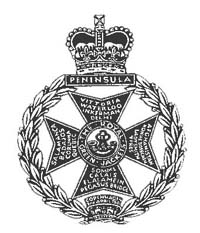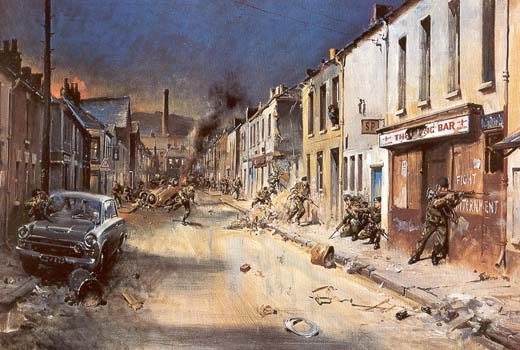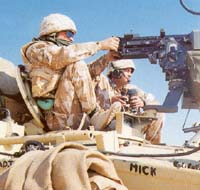|
THE
ROYAL GREEN JACKETS |
|

|
|
|
On
1st January 1966 the regiments of The Green Jackets Brigade took a further
step forward by transforming themselves into the three battalions of a
single 'Large Regiment': The Royal Green Jackets. And so the individual
identities of their famous forebears were merged into a single whole, and
in a few short years a generation has grown up owing no separate
allegiances, only a single one to the new Regiment.
Since
The Royal Green Jackets was formed, anew area of conflict has opened in
the shape of Northern Ireland and all battalions have taken their turn as
resident units or on emergency tours of duty. To the residue of overseas
garrisons of the immediate post-war years, such as Hong Kong and
Gibraltar, new ones have been added in Belize and the Falklands,
and all of these have seen Green Jackets since the Regiment was formed,
while the countries to which whole battalions or small parties have
travelled on exercises range from the USA and Canada to Morocco, Jordan,
Kenya and Nepal, to mention but a few.
Though
The Royal Green Jackets once more find themselves at a point in their
history where no specialised role distinguishes them from others, they
stand prepared to take the lead whenever the evolution of the military
environment so demands. What is certain is that their originality of
thinking and fostering of the family spirit still mark them out as
exceptional.
|
|

|
|
The Green
Jacket Legacy |
Regimental
histories often start with a description of traditions, as if they were in
themselves a source of pride; often they are only empty substitutes for
real achievements. Having traced the story, however, it is appropriate to
mention some of the forms by which historical events are remembered today. |
|
The Green
Jacket & the Rifle |
The
5th Battalion of the 60th was the first British infantry regiment to be
dressed in green and the Rifle Corps adopted a similar uniform from its
formation. The purpose was both practical and symbolic, representing the
first camouflage as required for the new open-order tactics and a clean
break with the rigid mechanical methods of 'redcoat' troops. Both
regiments were armed with rifles (the Hompesch rifle for the 60th and the
Baker for the Rifle Corps), a more accurate and longer-range weapon than
the musket but shorter and requiring along sword-bayonet to compensate in
close-quarter fighting, whence the use of the term 'sword' for bayonet in
Rifle Regiments. |
|
The
Bugle |
Open-order
tactics where individuals often found themselves beyond the range of the
human voice called for an efficient means of signalling to control
battlefield manoeuvres. The bugle provided the necessary communications
and a complex system of calls was developed, many of them still in use
today, while bugles replace the drums of other infantry on parade. |
|
The
Cap Badge

|
At
the centre is the bugle horn, the badge of all Rifle and Light Infantry
Regiments. The Maltese Cross is derived from the badges of both The King's
Royal Rifle Corps and The Rifle Brigade, while on its arms are some of the
Battle Honours of the former regiments, displayed in this way because
Green Jacket Regiments carry no colours. At the foot is the Naval Crown
awarded to The Rifle Brigade to commemorate their forebears' service under
Nelson at Copenhagen. |
|
Marching
Pace |
In
the eighteenth and nineteenth centuries the heavy infantry moved in close
formation at a slow con- trolled pace. Rifle and Light Infantry Regiments,
on the other hand, frequently on outpost duty, needed to move about the
battlefield faster, often at the 'double'. The Royal Green Jackets of
today habitually march at 140 paces to the minute compared to the standard
120 and retain the custom of the 'double-past' as a parade manoeuvre. |
|
Marksmanship |
The
introduction of the early rifles led to a tradition of marksmanship, as
Green Jackets were required to be the sharpshooters of the Army. Only in
recent years has the bulk of the Army started to devote the same attention
to the subject, despite the fact that rifles have been standard issue for
nearly 140 years. |
|
Discipline |
The
officers of the British Army of the eighteenth century have been described
as mainly incompetent and habitually drunk: their soldiers as largely
drawn from the criminal class. It was this unpromising material which a
succession of forward-thinking officers, many of them associated with
former Green Jacket Regiments and culminating in Sir John Moore, set to
work to turn into a dedicated and efficient fighting force by a system of
discipline based on thorough training and encouragement, rather than the
threat of the lash. Much of the Army was slow to follow, but the
principles of mutual trust and respect remain the foundation of Green
Jacket discipline today.
|
|
Innovation |
The
assumption that Green Jackets should be in the forefront of military
thinking long predates the name. The Royal Americans (described by Fuller
as 'the first true light infantry the British Standing Army ever had')
adopted equipment and tactics for a new role in forest warfare; the Light
Brigade brought the profession of light infantry to a pitch of perfection
in the Peninsular War and through the nineteenth century our predecessors
were constantly seeking ways of increasing mobility by developments in
mounted infantry using horses, camels and elephants. It was a logical
consequence that the 6Oth and Rifle Brigade should have been chosen to
pioneer the motor battalion concept in World War II, while the 52nd did
the same for air landing by glider.
|
|
The Future

|
The
lessons of past achievements and the example of illustrious predecessors
deserve to be remembered and traditions derived from them keep them alive,
but they are no substitute for an attitude of mind which sees the present
and the future as a challenge. For the last 250 years the regiments now
composing The Royal Green Jackets have led the way in facing each new
challenge of enemy, climate and technology which has faced the Army. In
1991 many of the assumptions on which military thinking has been based for
forty-five years -the threat from the Warsaw Pact, withdrawal from
overseas commitments - have been called into question. There have been
periods in the past when there seemed to be little scope for innovation
and the rest of the Army had caught up with the advanced thinking
pioneered by Green Jackets, but each time the opportunity to lead the way
has offered itself again and each time Green Jackets have seized it. There
is no reason why the present occasion should be any different. |



